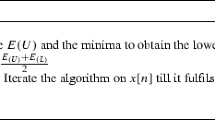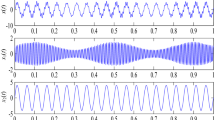Abstract
In this paper, a novel method that integrates the improved empirical mode decomposition (EMD) and signal energy algorithm is proposed to estimate the dominant oscillation parameters and corresponding mode shape. Firstly, the EMD with symmetrical extrema extension (SEE) is utilized to decompose the measured data from wide area measurement system (WAMS) into a finite set of intrinsic mode functions (IMFs). Then, the signal energy algorithm is used to calculate the approximate oscillation parameters of the IMFs. The nodes involved the dominant oscillation mode are classified based on the calculated frequency and reasonable threshold. Furthermore, for the dominant oscillation mode, the IMF with maximum mean amplitude is defined as the reference. Next, the relative phases (RPs) between the reference IMF and other IMFs are calculated in order to identify the negative and positive oscillation groups. According to the values of RPs, the coherent group and corresponding node contribution factor (NCF) can be identified, and the dominant approximate mode shape (AMS) can also be determined. The efficiency of the proposed approach is tested by applying it to synthetic signal and measured data from the simulation model.
Similar content being viewed by others
References
Lu Q, He G Y, Mei S W, et al. Advanced EMS and its trial operation in Shanghai Power Grid. Sci China Ser E-Tech Sci, 2008, 51(2): 220–224.
Yu Y X, Li P. The impact of weak interconnection of bulk power grids to damping and dynamic stability of power system. Proc CSEE, 2005, 25(11): 7–10
Zhu F, Zhao H G., Liu Z H, et al. The influence of large power grid interconnected on power system dynamic stability. Proceedings of the CSEE, 2007, 27(1): 1–7
Du W, Wang H, Cheng S, et al. Effect of embedded voltage source converter on power system oscillation damping. Sci China Tech Sci, 2010, 53: 892–901.
Kamwa I, Beland J, Trudel G, et al. Wide-area monitoring and control at Hydro-Quebec: Past, present and future, Proceedings on Power System Dynamic Performance Committee PES General Meeting, Montreal, Canada, Oct, 2006
Duan X Z, Su S, Mei N. Transmitting electric power system dynamics in SCADA using polynomial fitting. Sci China Ser E-Tech Sci, 2009, 52(4): 937–943
Trudnowski D J, Pierre J W. Overview of algorithms for estimating swing modes form measured responses, Proceedings on Power System Dynamic Performance Committee PES General Meeting, Calgary, Canada, July, 2009
Hashiguchi T, Yoshimoto M, Mitani Y, et al. Analysis of power system dynamics based on multiple synchronized phasor measurements. Proceedings on Power System Dynamic Performance Committee PES General Meeting, Ontario, Canada, Jul, 2003
Wiltshire R A, Ledwich G., OShea P. A Kalman filtering approach to rapidly detecting modal changes in power systems, IEEE Trans on Power Systems, 2007, 22(4): 1698–1706
Yuan Y, Sun Y Z, Cheng Lin, et al. Power system low frequency oscillation monitoring and analysis based on multi-signal online identification. Sci China Tech Sci, 2010, 53(9): 2589–2596
Rueda J L, Juarez C A, Erlich I. Wavelet-based analysis of power system low-frequency electromechanical oscillations. IEEE Trans Power Syst, 2011, 99(2): 1–11
Cai G W, Yang D Y, Jiao Y. et al. Power system low frequency oscillations analysis and parameter determination of adaptive PSS based on stochastic subspace identification, Proceedings in Power and Energy Engineering Conference, Chengdou, China, 2009
Messina A R, Vittal V, Ruiz-Vega D, et al. Interpretation and visualization of wide-area PMU measurements using Hilbert analysis, IEEE Trans Power Syst, 2006, 21(4): 1763–1761
Messina A R. Inter-area Oscillations in Power Systems: A Non-linear and Non-stationary Perspective, Berlin: Springer Press, 2009. 63–126
Huang N E, Shen Z, Long S R, et al. The empirical mode decomposition and the Hilbert spectrum for non-linear and non-stationary time series analysis. P Roy Soc Lond A Mat, 454(1971): 903–995
Yang D C, Rehtanz C, Li Y. Analysis of low frequency oscillations using improved Hilbert-Huang transform, 2010 International Conference on Power System Technology (POWERCON), Hangzhou, China, Oct, 2010
Mu G., Shi K P, An J, et al. Signal energy method based on EMD and its application to research of low frequency oscillation. Proc CSEE, 2008, 28(19): 36–41
Kundur P. Power System Stability and Control. McGraw-Hill, NewYork, 1994. 885–897
Duan G., Lin J J, Wu J T. Analysis method of node contribution factor of low frequency oscillation based on wide area measurement information. CN101408577A, 2009. 4–15
Author information
Authors and Affiliations
Corresponding author
Rights and permissions
About this article
Cite this article
Yang, D., Rehtanz, C., Li, Y. et al. A novel method for analyzing dominant oscillation mode based on improved EMD and signal energy algorithm. Sci. China Technol. Sci. 54, 2493–2500 (2011). https://doi.org/10.1007/s11431-011-4497-7
Received:
Accepted:
Published:
Issue Date:
DOI: https://doi.org/10.1007/s11431-011-4497-7




